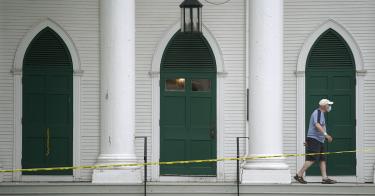When the statewide lockdowns first began in response to the COVID-19 pandemic, most Americans accepted these measures in good faith as a difficult, but necessary, sacrifices for the benefit of everyone.
At the time, the only thing anyone truly understood about the novel coronavirus that causes the disease was its breathtaking speed and seemingly unstoppable lethality in certain cities.
But lockdown measures were meant only to bridge us to a solution for dealing with COVID-19, and it should be the goal of lawmakers to return as much of American life back to normal as possible.
As we learn more, we should use every piece of information to loosen lockdown restrictions when possible, especially where it affects fundamental parts of our lives. Such restrictions include needlessly restrictive occupancy rules on places of worship that have been a mainstay of mitigation measures throughout the country.
Solid information about COVID-19 is difficult to come by and policy implications from one place is often difficult to generalize to another, which makes it difficult to judge their effectiveness or utility. When any clear information presents itself, policymakers should take advantage of it.
Maine and New Hampshire have different sets of COVID-19 measures, but because they are demographically and geographically similar states, they present an effective natural experiment.
Both Maine and New Hampshire currently are experiencing consistently low or declining numbers of COVID-19 cases, hospitalizations, and deaths, and both states consistently have remained well below the national averages in both absolute and per capita terms.
By June, both states also relaxed occupancy restrictions on places of worship. But Maine went from a 10-person maximum to a 50-person maximum, and New Hampshire went from a 10-person maximum to a maximum of 50% capacity.
One month later, neither state faces concerning rises in COVID-19 numbers the way several other states have.
That being the case, what reason does Maine have in maintaining such tight occupancy restrictions on places of worship? Indeed, what was the reasoning behind such an arbitrary number as 50 persons?
A small chapel may be filled beyond capacity with fewer than 50 persons, but the Cathedral of the Immaculate Conception in Portland, Maine, can seat 900 congregants. Such a large space certainly should be safe with a few more churchgoers than 50, which is only 5.5% of the 900-seat capacity.
Limited occupancy is not the only measure that places of worship will follow, since other guidelines govern all institutions and establishments, such as minimum requirements for spacing between persons, employment requirements, and promotion of good health practices.
Many of these additional requirements in New Hampshire are somewhat subjective in implementation, such as the requirement to promote mask wearing or the recommendation that places of worship have more services to reduce attendance at any one service.
But this is no reason for concern. After all, who cares more for the parishioners, the state’s governor or the pastor?
Skeptics might dismiss the return to church as an unnecessary ritual that can be set aside for a few months longer, but already, these restrictions have resulted in some of the cruelest human outcomes.
The same lockdown measures meant to curb the spread of the disease also forced us to leave loved ones to die alone in hospitals and, when the time came to mourn their loss, families had to choose who could attend the services lest they run afoul of occupancy or crowd-size regulations.
This is not hypothetical.
Restrictions implemented in the name of disease prevention may at times be deemed necessary; however, lawmakers must never forget that the parts of our lives that make us feel normal are not mere luxuries, but are the very things that make us human.
If governments decide to restrict our lives and our foundational freedoms, in this case that of religious expression, they must actively pursue the return of those rights or citizens must never be silent about them. Other debates about offices, salons, and schools often have been written off as the frivolous whims of a reckless public, but also are key parts of our lives and the lives of our children.
We accepted the many restrictions of lockdowns in good faith, but every rollback of our freedoms must be scrutinized for rationale and released at the soonest possible moment.
Maine has exactly zero reason to restrict church attendance to 50 persons. And now that we have learned much from the beginning of this pandemic, lifting that restriction should be only a start for the whole country.
This piece originally appeared in The Daily Signal




